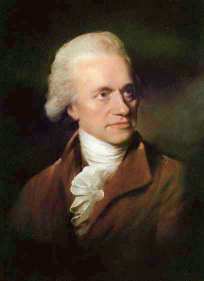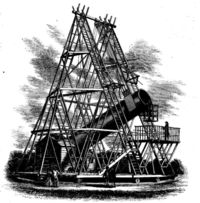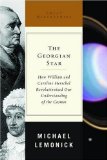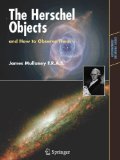Herschel was a famous astronomer and telescope maker who lived from 1738 to 1822.
 The science and art of astronomy and telescope making owes a lot to William and his sister Caroline. He was a famous astronomer and held the title of “Kings Astronomer:” And he was the most renowned astronomer of his time.
The science and art of astronomy and telescope making owes a lot to William and his sister Caroline. He was a famous astronomer and held the title of “Kings Astronomer:” And he was the most renowned astronomer of his time.
As a telescope maker his largest telescope remained the largest in the world for about 50 years. He did a lot of work and made some important discoveries in the field of astronomy. But his most famous achievements were his telescopes. He built over 400 of them and they got progressively larger until the largest one was built which was over 40 feet in length with an aperture of 49 and 1/2 inches. This telescope is pictured below at left.
A Claim To Fame and the Calling of Professional Astronomer
Table of Contents
He was an avid amateur astronomer but this turned to a full time profession when he discovered the planet Uranus on March 13th, 1781. This brought him a lot of fame and is how he became the Kings Astronomer.
 One of the unique things about his telescopes was that while there was a primary mirror as in the newtonian there was no secondary mirror. He would make his observations by peering down the tube directly at the mirror. You can envision this by looking at the picture. That would be Herschel standing on the platform. It would be raised and he would look down the tube at the mirror. In effect his head would block out some of the light gathering power of the telescope.
One of the unique things about his telescopes was that while there was a primary mirror as in the newtonian there was no secondary mirror. He would make his observations by peering down the tube directly at the mirror. You can envision this by looking at the picture. That would be Herschel standing on the platform. It would be raised and he would look down the tube at the mirror. In effect his head would block out some of the light gathering power of the telescope.
The 40 foot telescope that he was famous for (shown in picture) was a rather cumbersome instrument due to its size. So most of the discoveries and observations he made were with a smaller (20 foot) telescope.
Some of his discoveries
- Uranus – 1781
- Two Moons of Saturn – ( Mimas and Enceladus)
- Two Moons of Uranus – ( Titania and Oberon)
- He coined the word “asteroid” from the Greek for
- He created an extensive catalog of nebulae called the Herschel Catalog (It has over 2500 listings)
- He discovered that most double stars were not optical doubles but actual binary stars that revolve around each other. This proved the first proof of Newton’s laws of gravitation applied outside our solar system.
His sister Caroline
He gave his sister a telescope as a gift and it inspired her to pursue astronomy. She was his constant companion and note taker for his observations. But she also made many discoveries of her own including eight comets and the discovery of M110 which is the second companion to the andromeda galaxy.
The Herschel Museum of Astronomy – Their website
His home where he lived is now a museum dedicated to him, his work and that of his sister Caroline. It is located at 19 New King street in Bath England.
Books By and about William Herschel
The Georgian Star: How William and Caroline Herschel Revolutionized Our Understanding of the Cosmos (Great Discoveries)
Former Time magazine science writer Lemonick provides an entertaining and illuminating look at a pathbreaking astronomical partnership. When William Herschel, in 1781, discovered Uranus (which he named the Georgian Star in hopes of getting much-needed funding from King George), he was a self-taught amateur astronomer earning his living as a musician.
 When the king offered Herschel £200 per year-a 50% drop in income-the astronomer gladly accepted the chance to become the king’s astronomer. His goal was to discover how the universe was constructed, and Herschel, an obsessive observer, made a remarkable number of discoveries, including infrared radiation. He also taught his sister Caroline to help with his work, and soon she was publishing her own discoveries, hunting comets and cataloguing thousands of stars and nebulae. When the king agreed to give her a salary, she became the first paid woman scientist. Lemonick ( Echo of the Big Bang ) paints a vibrant and revealing picture of these two scientists whose painstaking observation and cataloguing paved the way for modern astronomy. 9 illus. (Nov.) Copyright © Reed Business Information, a division of Reed Elsevier Inc. All rights reserved.
When the king offered Herschel £200 per year-a 50% drop in income-the astronomer gladly accepted the chance to become the king’s astronomer. His goal was to discover how the universe was constructed, and Herschel, an obsessive observer, made a remarkable number of discoveries, including infrared radiation. He also taught his sister Caroline to help with his work, and soon she was publishing her own discoveries, hunting comets and cataloguing thousands of stars and nebulae. When the king agreed to give her a salary, she became the first paid woman scientist. Lemonick ( Echo of the Big Bang ) paints a vibrant and revealing picture of these two scientists whose painstaking observation and cataloguing paved the way for modern astronomy. 9 illus. (Nov.) Copyright © Reed Business Information, a division of Reed Elsevier Inc. All rights reserved.
Sir William Herschel His Life and Works – This scarce antiquarian book is included in our special Legacy Reprint Series.
 In the interest of creating a more extensive selection of rare historical book reprints, we have chosen to reproduce this title even though it may possibly have occasional imperfections such as missing and blurred pages, missing text, poor pictures, markings, dark backgrounds and other reproduction issues beyond our control. Because this work is culturally important, we have made it available as a part of our commitment to protecting, preserving and promoting the world’s literature.
In the interest of creating a more extensive selection of rare historical book reprints, we have chosen to reproduce this title even though it may possibly have occasional imperfections such as missing and blurred pages, missing text, poor pictures, markings, dark backgrounds and other reproduction issues beyond our control. Because this work is culturally important, we have made it available as a part of our commitment to protecting, preserving and promoting the world’s literature.
The Herschel Objects and How to Observe Them (Astronomers’ Observing Guides) – Amateur astronomers – particularly deep-sky observers – are always on the lookout for new observing challenges.
 The Herschel Objects, and How to Observe Them offers the exciting opportunity of retracing the steps of the greatest visual observer and celestial explorer that ever lived. This is a practical guide to seeing the most impressive of Herschel’s star clusters, nebulae and galaxies.
The Herschel Objects, and How to Observe Them offers the exciting opportunity of retracing the steps of the greatest visual observer and celestial explorer that ever lived. This is a practical guide to seeing the most impressive of Herschel’s star clusters, nebulae and galaxies.
There has never been – and as of the time of submitting this proposal there still isn’t – an observer’s book devoted to the Herschel objects. The US-based Astronomical League has for several years sponsored a “Herschel Club”, reflecting the interest amateur astronomers have in this important but less widely known listing. The Herschel Objects, and How to Observe Them covers more than 600 of the brightest of the objects that Herschel saw, with detailed descriptions and images of 150 to 200 of the very best for viewing with amateur telescopes.
